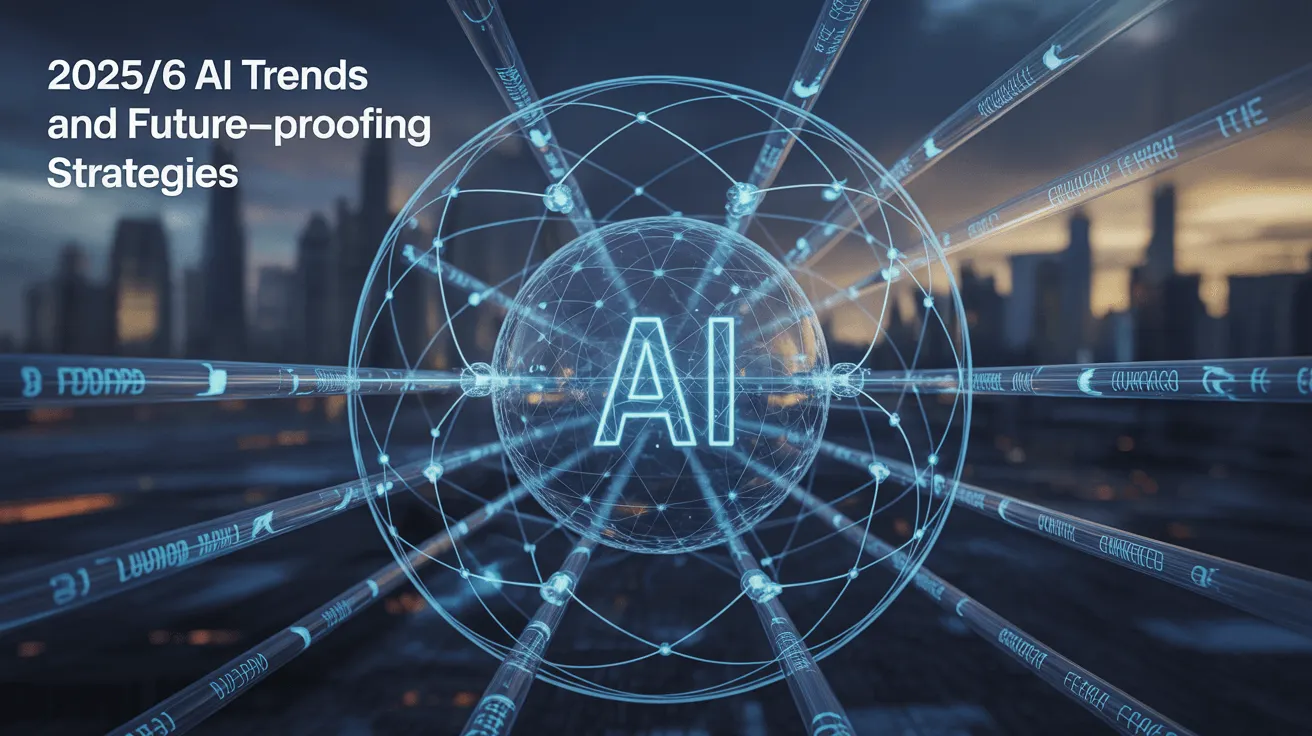AI Strategy for Mid-Market Businesses in 2025/6: The Complete Implementation Guide
Mid-market companies that fail to adopt artificial intelligence by 2025/26 risk becoming obsolete. While 78% of enterprise organizations have already implemented AI solutions, only 34% of mid-market businesses have moved beyond pilot programs, creating a dangerous competitive gap that threatens to widen exponentially in the coming year.

Key Takeaways
• Strategic AI roadmapping with phased implementation can deliver 15-30% operational efficiency gains within 18 months • Workforce transformation and upskilling programs are critical for successful AI adoption, with companies seeing 40% higher success rates when employees are properly trained • Industry-specific AI applications in manufacturing, financial services, healthcare, and retail offer the highest ROI potential for mid-market organizations • Risk mitigation frameworks tailored for mid-market resources can prevent the 67% failure rate seen in poorly planned AI implementations • Cost-effective AI solutions now make enterprise-grade capabilities accessible to companies with $10M-$1B in annual revenue
Executive Summary
The artificial intelligence revolution has reached a critical inflection point for mid-market businesses. Recent research from McKinsey Global Institute reveals that mid-market companies implementing comprehensive AI strategies are experiencing 23% faster revenue growth compared to their non-AI counterparts, while simultaneously reducing operational costs by an average of 19%.
As we are in 2025, five strategic imperatives emerge as non-negotiable for mid-market success:
- Strategic AI Roadmapping and Prioritization - Developing clear, phased implementation plans that align with business objectives
- Workforce Transformation and AI-Human Collaboration - Creating upskilling programs that enhance rather than replace human capabilities
- Technology Infrastructure and Integration - Building scalable, secure foundations for AI deployment
- Responsible AI and Risk Management - Implementing governance frameworks that ensure ethical and compliant AI use
- Measuring ROI and Scaling Success - Establishing metrics and methodologies for continuous improvement and expansion
Companies following this strategic framework report impressive results: manufacturing firms achieve 25-40% reductions in downtime, financial services organizations see 35-50% improvements in fraud detection, and healthcare providers reduce administrative costs by 20-30% while improving patient outcomes.
The window of opportunity remains open, but it's closing rapidly. Mid-market businesses that begin their AI transformation journey in 2025/26 can still capture significant competitive advantages, but delay beyond this point may result in insurmountable market disadvantages. This comprehensive guide provides the roadmap, tools, and insights necessary to navigate this transformation successfully.
The Mid-Market AI Landscape: Current State and 2025/26 Outlook
Market Size and Growth Projections
The mid-market AI adoption landscape represents one of the most significant untapped opportunities in technology today. According to Gartner's latest research, the global AI market for mid-market businesses is projected to reach $47.3 billion by 2026/7, representing a compound annual growth rate of 28.4% from 2023 levels.

This explosive growth is driven by several converging factors:
- Democratization of AI tools through cloud platforms and SaaS solutions
- Reduced implementation costs making AI accessible to smaller budgets
- Improved user interfaces requiring less technical expertise
- Industry-specific solutions designed for mid-market needs
PwC's 2024 AI Survey indicates that mid-market companies investing in AI see average productivity gains of 31% within the first 24 months of implementation, with the most successful organizations achieving improvements exceeding 45%.
💡 Key Insight: Mid-market businesses have a unique advantage - they can learn from enterprise AI implementations while avoiding many of the complexity and integration challenges that larger organizations face.
Competitive Pressure Analysis: How AI Leaders Are Pulling Ahead
The competitive landscape is rapidly stratifying between AI adopters and AI laggards.
Companies that have successfully implemented AI strategies are creating sustainable competitive moats through:
Enhanced Customer Experience: AI-powered personalization and customer service automation enable mid-market companies to compete with larger enterprises on customer satisfaction metrics. Early adopters report customer retention improvements of 15-25% and customer acquisition cost reductions of 20-35%.
Operational Efficiency Gains: Predictive maintenance, supply chain optimization, and automated quality control processes allow AI-enabled companies to operate at efficiency levels previously achievable only by much larger organizations with extensive resources.
Data-Driven Decision Making: Advanced analytics and AI-powered insights enable faster, more accurate business decisions. Companies with mature AI implementations make strategic decisions 40% faster than competitors relying on traditional analysis methods.
Innovation Acceleration: AI tools for research and development, market analysis, and product design significantly accelerate innovation cycles. Mid-market AI leaders bring new products to market 25-30% faster than traditional competitors.
Regulatory Landscape and Compliance Considerations
The regulatory environment for business AI implementation is evolving rapidly, with significant implications for mid-market organizations.
Key developments include:
The EU AI Act: Fully implemented in 2024, this comprehensive framework establishes risk-based regulations for AI systems. Mid-market companies operating in or with European markets must ensure compliance with transparency, accountability, and safety requirements.
US Executive Orders on AI: Federal guidelines emphasize responsible AI development and deployment, with particular focus on bias prevention, privacy protection, and algorithmic transparency.
Industry-Specific Regulations: Financial services (GDPR, SOX compliance), healthcare (HIPAA), and manufacturing (safety standards) sectors face additional AI-related compliance requirements.
State-Level Legislation: California's AI transparency laws and similar regulations in other states create a complex compliance landscape for multi-state operations.
Addressing the AI Maturity Gap
The "AI maturity gap" between enterprise and mid-market adoption stems from several factors:
- Resource Constraints: Limited IT staff and budgets for complex implementations
- Knowledge Gaps: Lack of AI expertise and strategic planning capabilities
- Risk Aversion: Concerns about disruption to existing operations
- Vendor Complexity: Difficulty navigating the crowded AI vendor landscape

However, this gap also represents an opportunity. Mid-market companies can leverage lessons learned from enterprise implementations, access mature technologies at lower costs, and implement AI solutions with greater agility than larger organizations constrained by legacy systems and complex approval processes.
Five Critical AI Strategy Pillars for Mid-Market Success
Pillar 1: Strategic AI Roadmapping and Prioritization
Strategic AI roadmapping forms the foundation of successful mid-market AI transformation. Unlike enterprise organizations that can afford to pursue multiple AI initiatives simultaneously, mid-market companies must be strategic about prioritization and sequencing.
The Value-Impact-Feasibility Framework provides an effective method for identifying high-impact use cases:
Value Assessment: Quantify potential business impact in terms of revenue generation, cost reduction, or risk mitigation. Focus on use cases that can deliver minimum 15% improvement in key business metrics.
Impact Analysis: Evaluate how AI implementation will affect customers, employees, and operations. Prioritize initiatives that enhance rather than disrupt core business processes.
Feasibility Evaluation: Assess technical requirements, data availability, and organizational readiness. Begin with use cases requiring minimal infrastructure changes.
Timeline Recommendations:
- 6-Month Phase: Pilot implementation of 1-2 high-value, low-complexity use cases
- 12-Month Phase: Scale successful pilots and introduce 2-3 additional AI applications
- 24-Month Phase: Enterprise-wide deployment and advanced AI capabilities integration
Resource Allocation Guidelines: Allocate 60% of AI budget to proven use cases with clear ROI, 30% to promising experimental applications, and 10% to emerging technology evaluation.
🎯 Action Item: Create a use case prioritization matrix scoring each potential AI application on value (1-10), impact (1-10), and feasibility (1-10). Focus initial efforts on applications scoring 24+ total points.
Pillar 2: Workforce Transformation and AI-Human Collaboration
Workplace AI transformation success depends more on people than technology. Organizations with comprehensive AI workforce development programs achieve 40% higher implementation success rates compared to those focusing solely on technology deployment.
Upskilling Strategies and Training Programs:
Implement a three-tier training approach:
- Executive Education: C-suite and senior leadership AI strategy workshops focusing on business impact and decision-making frameworks
- Manager Enablement: Department heads and team leaders receive training on AI project management, change leadership, and performance measurement
- Employee Development: Hands-on training for end-users, emphasizing AI tool usage, workflow integration, and collaborative problem-solving
Change Management Best Practices:
- Transparent Communication: Regular updates on AI initiatives, addressing concerns and highlighting benefits
- Gradual Implementation: Phased rollouts allowing employees to adapt progressively
- Success Celebration: Recognizing and sharing early wins to build momentum and enthusiasm
- Feedback Loops: Continuous collection and incorporation of employee input
Employee Engagement and Adoption Tactics:
Successful AI-human collaboration requires intentional design of workflows that enhance human capabilities rather than replacing them. Focus on:
- Augmentation Over Automation: Position AI as a tool that makes employees more effective rather than threatens job security
- Skill Enhancement: Emphasize how AI enables employees to focus on higher-value, creative, and strategic activities
- Career Development: Provide clear pathways for advancing AI-related skills and responsibilities
Pillar 3: Technology Infrastructure and Integration
AI technology integration for mid-market businesses requires balancing capability needs with resource constraints. The infrastructure strategy should prioritize flexibility, scalability, and cost-effectiveness.
Cloud-First vs. Hybrid Approaches:
For most mid-market organizations, a cloud-first strategy offers optimal benefits:
- Reduced Capital Investment: Eliminate expensive hardware purchases and maintenance
- Scalability: Easily adjust computing resources based on demand
- Access to Advanced Tools: Leverage cutting-edge AI services without in-house development
- Security and Compliance: Benefit from enterprise-grade security provided by major cloud platforms
Hybrid approaches may be appropriate for organizations with:
- Existing significant on-premises investments
- Specific regulatory requirements for data residency
- Unique performance or latency requirements
API Integration Strategies:
Successful business AI implementation requires seamless integration with existing systems. Key considerations include:
- RESTful API Standards: Ensure all AI solutions support standard integration protocols
- Data Flow Mapping: Document how information moves between AI systems and existing applications
- Error Handling: Implement robust fallback procedures for AI system failures
- Version Management: Plan for AI model updates and system evolution
Data Readiness Assessment Framework:
AI success depends on data quality and accessibility. Evaluate:
- Data Availability: Catalog existing data sources and identify gaps
- Data Quality: Assess completeness, accuracy, and consistency
- Data Governance: Establish policies for access, privacy, and security
- Data Infrastructure: Ensure adequate storage, processing, and backup capabilities
Pillar 4: Responsible AI and Risk Management
Responsible AI implementation is not just an ethical imperative—it's a business necessity that protects against legal, financial, and reputational risks.
Governance Frameworks Tailored for Mid-Market Resources:
Mid-market companies need streamlined governance approaches that provide adequate oversight without overwhelming limited resources:
- AI Ethics Committee: 3-5 person committee including legal, IT, and business representation
- Use Case Review Process: Standardized evaluation criteria for new AI applications
- Regular Auditing: Quarterly reviews of AI system performance and compliance
- Incident Response Plan: Clear procedures for addressing AI-related issues
Bias Detection and Mitigation Strategies:
Implement systematic approaches to identify and address AI bias:
- Diverse Training Data: Ensure AI training datasets represent all relevant populations and scenarios
- Regular Testing: Continuously evaluate AI outputs for discriminatory patterns
- Human Oversight: Maintain human review processes for high-stakes decisions
- Transparency Requirements: Document AI decision-making processes and criteria
Privacy and Security Protocols:
AI systems often process sensitive data, requiring enhanced security measures:
- Data Encryption: Encrypt data at rest and in transit
- Access Controls: Implement role-based permissions for AI system access
- Audit Trails: Maintain detailed logs of AI system interactions and decisions
- Privacy by Design: Build privacy protections into AI systems from inception
Pillar 5: Measuring ROI and Scaling Success
AI ROI mid-market companies can achieve depends on establishing appropriate measurement frameworks and scaling methodologies from the outset.
KPI Frameworks Specific to Mid-Market Constraints:
Focus on metrics that directly tie to business outcomes:
- Financial Metrics: Revenue impact, cost reduction, profit margin improvement
- Operational Metrics: Efficiency gains, error reduction, processing time improvements
- Customer Metrics: Satisfaction scores, retention rates, acquisition costs
- Employee Metrics: Productivity improvements, job satisfaction, skill development
Scaling Methodologies from Pilot to Enterprise-Wide Deployment:
Successful scaling requires systematic approaches:
- Pilot Validation: Thoroughly test AI solutions in controlled environments
- Gradual Expansion: Incrementally increase scope and complexity
- Cross-Functional Integration: Ensure AI solutions work across departments
- Continuous Optimization: Regular refinement based on performance data
Budget Optimization Strategies:
Maximize AI investment returns through strategic resource allocation:
- Shared Services Approach: Leverage AI capabilities across multiple departments
- Vendor Consolidation: Reduce complexity and costs through strategic partnerships
- Open Source Integration: Utilize free and low-cost AI tools where appropriate
- Performance-Based Contracts: Tie vendor payments to measurable outcomes
📊 Success Metric: Aim for positive ROI within 12-18 months for initial AI implementations, with break-even occurring by month 8-12 for most use cases.

Industry-Specific Implementation Blueprints
Manufacturing Sector
Mid-market digital transformation in manufacturing offers some of the most compelling AI ROI opportunities, with companies typically seeing 20-40% efficiency improvements within 18 months of implementation.
Predictive Maintenance Use Cases with ROI Examples:
Predictive maintenance represents the highest-impact AI application for most manufacturers. By analyzing equipment sensor data, vibration patterns, and historical maintenance records, AI systems can predict failures 2-4 weeks in advance.
ROI Example: A mid-market automotive parts manufacturer with 150 machines implemented predictive maintenance AI:
- Investment: $180,000 (software, sensors, implementation)
- Annual Savings: $420,000 (reduced downtime, lower maintenance costs)
- Payback Period: 5.1 months
- 3-Year ROI: 340%
Supply Chain Optimization Opportunities:
AI-powered supply chain optimization addresses inventory management, demand forecasting, and logistics coordination:
- Demand Forecasting: Improve accuracy by 15-25% using AI analysis of market trends, seasonal patterns, and customer behavior
- Inventory Optimization: Reduce carrying costs by 20-30% while maintaining service levels
- Logistics Coordination: Optimize shipping routes and schedules for 10-15% cost reduction
Quality Control Automation:
Computer vision and machine learning enable automated quality inspection:
- Defect Detection: Identify quality issues 95%+ accuracy rates
- Consistency Improvement: Reduce quality variations by 30-50%
- Labor Optimization: Redeploy quality inspectors to higher-value activities
Financial Services
AI adoption strategies for medium-sized businesses in financial services focus on risk management, customer service, and regulatory compliance.
Fraud Detection and Risk Assessment:
AI-powered fraud detection systems analyze transaction patterns, user behavior, and risk indicators in real-time:
- Fraud Reduction: Decrease fraudulent transactions by 40-60%
- False Positive Reduction: Reduce legitimate transaction blocks by 25-35%
- Processing Speed: Real-time analysis versus traditional batch processing
Customer Service Automation:
Intelligent chatbots and virtual assistants handle routine customer inquiries:
- Cost Reduction: Lower customer service costs by 30-45%
- Response Time: Provide 24/7 immediate responses for common questions
- Satisfaction Improvement: Faster resolution increases customer satisfaction scores by 15-20
Regulatory Compliance Automation:
AI systems automate compliance monitoring and reporting:
- Monitoring Efficiency: Continuous compliance checking versus periodic manual reviews
- Risk Identification: Early detection of potential compliance issues
- Reporting Automation: Reduce compliance reporting time by 50-70%
Healthcare & Life Sciences
AI implementation roadmap for growing companies in healthcare emphasizes patient care improvement and administrative efficiency.
Patient Care Optimization:
AI applications enhance clinical decision-making and patient outcomes:
- Diagnostic Support: AI-assisted diagnosis improves accuracy by 10-15%
- Treatment Recommendations: Personalized treatment plans based on patient data analysis
- Risk Prediction: Early identification of patients at risk for complications
Administrative Efficiency Gains:
Healthcare administration offers significant AI automation opportunities:
- Appointment Scheduling: Intelligent scheduling reduces no-shows by 20-25%
- Claims Processing: Automated claims review and submission
- Documentation: AI-assisted medical documentation saves 2-3 hours per provider daily
Diagnostic Support Systems:
AI-powered diagnostic tools support clinical decision-making:
- Medical Imaging: Enhanced analysis of X-rays, MRIs, and CT scans
- Laboratory Results: Pattern recognition in lab data
- Clinical Decision Support: Evidence-based treatment recommendations
Retail & E-commerce
Cost-effective AI solutions for mid-market retailers focus on personalization, inventory management, and customer experience enhancement.
Personalization Engines:
AI-driven personalization increases sales and customer loyalty:
- Revenue Increase: Personalized recommendations drive 15-25% sales growth
- Customer Engagement: Increased time on site and pages per visit
- Conversion Improvement: Higher conversion rates through relevant product suggestions
Inventory Optimization:
AI-powered inventory management reduces costs and improves availability:
- Stock Reduction: Decrease inventory carrying costs by 20-30%
- Stockout Prevention: Reduce out-of-stock situations by 40-50%
- Demand Forecasting: Improve forecast accuracy by 25-35%
Customer Experience Enhancement:
AI improves customer interactions across all touchpoints:
- Chatbot Support: 24/7 customer service with 80-90% issue resolution
- Search Optimization: Intelligent search improves product discovery
- Price Optimization: Dynamic pricing strategies increase margins by 5-15%
Real-World Success Stories and Case Studies
Case Study 1: Mid-Market Manufacturer Achieving 25% Efficiency Gains
Company Profile: Regional automotive parts manufacturer, $85M annual revenue, 420 employees
Challenge: Rising production costs, increasing quality control issues, and maintenance-related downtime affecting profitability and customer satisfaction.

AI Implementation Strategy: The company implemented a comprehensive AI transformation mid-market approach focusing on three core areas:
- Predictive Maintenance System: IoT sensors and machine learning algorithms monitoring 180 critical machines
- Quality Control Automation: Computer vision systems inspecting 100% of produced parts
- Production Optimization: AI-driven scheduling and resource allocation
Implementation Timeline:
- Months 1-3: Infrastructure setup and pilot program on 20 machines
- Months 4-8: Gradual rollout to all production lines
- Months 9-12: System optimization and advanced feature deployment
Results Achieved:
- Overall Efficiency Improvement: 27% increase in overall equipment effectiveness (OEE)
- Downtime Reduction: 42% decrease in unplanned maintenance downtime
- Quality Improvements: 38% reduction in defect rates
- Cost Savings: $1.2M annual savings against $340K implementation investment
- Payback Period: 4.2 months
Key Lessons Learned:
- Employee training and change management were critical success factors
- Starting with a focused pilot program built confidence and momentum
- Integration with existing ERP systems required more time than initially planned
- Regular communication with production teams improved adoption rates
💪 Success Factor: "The key was positioning AI as a tool to make our workers more effective, not replace them. Our employees became our biggest advocates once they saw how AI helped them do their jobs better." - Operations Director
Case Study 2: Regional Bank Reducing Fraud by 40% with AI
Company Profile: Community bank with $2.8B in assets, serving mid-market commercial clients and retail customers across three states.
Challenge: Increasing fraud losses, high false positive rates causing customer friction, and manual review processes creating operational bottlenecks.
AI Solution Implementation: The bank deployed a comprehensive AI competitive advantage strategy centered on intelligent fraud detection:
- Real-Time Transaction Monitoring: Machine learning algorithms analyzing transaction patterns
- Customer Behavior Analysis: AI models learning individual customer spending habits
- Risk Scoring System: Dynamic risk assessment for all transactions
Implementation Details:
- Technology Partner: Collaborated with a specialized fintech AI vendor
- Data Integration: Connected AI system to core banking platform and card processing networks
- Compliance Framework: Ensured all AI decisions included audit trails for regulatory requirements
Measurable Outcomes:
- Fraud Reduction: 43% decrease in successful fraudulent transactions
- False Positive Improvement: 31% reduction in legitimate transactions flagged as suspicious
- Processing Speed: Real-time decision making versus 4-6 hour manual review delays
- Customer Satisfaction: 18% improvement in customer service scores related to card services
- Annual Savings: $890K in fraud losses prevented and operational cost reduction
Implementation Investment: $420K total (software licensing, integration, training) ROI Timeline: Break-even achieved in 7 months, 212% ROI over 24 months
Critical Success Elements:
- Extensive testing with historical fraud data before deployment
- Gradual rollout starting with lower-risk transaction types
- Continuous model refinement based on new fraud patterns
- Staff training on AI-assisted investigation techniques
Case Study 3: Healthcare Provider Improving Patient Outcomes
Organization Profile: Mid-market healthcare system with 3 hospitals and 12 clinics, serving 180,000 patients annually
Operational Challenges: Administrative inefficiencies, patient scheduling difficulties, and inconsistent care coordination across facilities.
AI-Powered Solutions: The healthcare system implemented responsible AI implementation focusing on patient care enhancement:
- Intelligent Scheduling System: AI optimization of appointment scheduling and resource allocation
- Clinical Decision Support: AI-assisted diagnosis and treatment recommendations
- Administrative Automation: Automated insurance verification and claims processing
Deployment Strategy:
- Phase 1: Pilot program at one clinic for scheduling optimization
- Phase 2: Clinical decision support rollout to emergency departments
- Phase 3: System-wide implementation including administrative automation
Patient Outcome Improvements:
- Appointment Efficiency: 28% reduction in patient wait times
- Care Coordination: 35% improvement in care continuity across facilities
- Diagnostic Accuracy: 12% increase in early detection of critical conditions
- Patient Satisfaction: 22% improvement in overall patient experience scores
- Administrative Efficiency: 45% reduction in insurance verification processing time
Financial Impact:
- Revenue Increase: $2.1M annual increase through improved efficiency and capacity utilization
- Cost Reduction: $1.4M savings in administrative costs
- Investment Required: $650K implementation and training costs
- Net ROI: 540% over 36 months
Lessons for Healthcare AI Implementation:
- Physician buy-in was essential for clinical decision support adoption
- Patient privacy and data security required extensive planning and testing
- Integration with electronic health records (EHR) systems was complex but crucial
- Continuous monitoring ensured AI recommendations remained clinically appropriate
🏥 Healthcare Insight: "AI didn't replace our clinical judgment—it enhanced it. Our physicians now have better information to make decisions, and our patients receive more consistent, evidence-based care." - Chief Medical Officer
Cost-Benefit Analysis and Investment Framework
Total Cost of Ownership Models for Different AI Implementations
Understanding the complete financial picture of AI ROI mid-market companies can achieve requires comprehensive cost analysis beyond initial software purchases.
The Total Cost of Ownership (TCO) framework provides realistic investment planning.

AI Implementation Cost Categories:
Software and Licensing Costs (30-40% of total TCO):
- AI platform licensing fees
- Integration software and APIs
- Ongoing subscription costs
- Version upgrades and maintenance
Infrastructure Investments (20-25% of total TCO):
- Cloud computing resources
- Data storage and backup systems
- Network upgrades for AI workloads
- Security enhancements
Implementation and Integration (25-30% of total TCO):
- Professional services and consulting
- Custom development and configuration
- System integration and testing
- Data migration and cleanup
Training and Change Management (15-20% of total TCO):
- Employee training programs
- Change management consulting
- Productivity loss during transition
- Ongoing education and certification
Expected Payback Periods by Use Case Category
High-Impact, Quick-Return Use Cases (6-12 month payback):
- Customer Service Chatbots: Average 8-month payback through reduced support costs
- Fraud Detection Systems: 6-10 month payback via loss prevention
- Predictive Maintenance: 8-14 month payback through downtime reduction
Medium-Impact, Moderate-Return Use Cases (12-24 month payback):
- Supply Chain Optimization: 15-20 month payback through inventory and logistics improvements
- Quality Control Automation: 12-18 month payback via defect reduction and labor optimization
- Sales Forecasting and CRM: 18-24 month payback through improved sales effectiveness
Strategic, Long-Term Use Cases (24-36 month payback):
- Product Development AI: 24-30 month payback through faster innovation cycles
- Comprehensive Business Intelligence: 30-36 month payback via improved decision-making
- Advanced Personalization Engines: 24-36 month payback through customer lifetime value increases
Funding Strategies and Budget Allocation Recommendations
Phased Investment Approach: Rather than large upfront investments, successful mid-market companies use staged funding strategies:
Year 1 Budget Allocation:
- 50% - Pilot programs and proof-of-concept projects
- 30% - Infrastructure and foundational capabilities
- 20% - Training and change management
Year 2-3 Budget Allocation:
- 60% - Scaling successful pilots and new implementations
- 25% - Advanced capabilities and integration
- 15% - Optimization and continuous improvement
Funding Source Strategies:
- Operational Budget Reallocation: Fund AI through efficiency savings in existing operations
- Technology Refresh Cycles: Replace aging systems with AI-enabled alternatives
- Revenue-Based Financing: Use AI-generated revenue improvements to fund expansion
- Strategic Partnerships: Share costs and risks with technology vendors or implementation partners
Hidden Costs and How to Avoid Them
Data Preparation and Quality Issues: Many organizations underestimate data preparation costs, which can represent 60-80% of AI project effort. Mitigate through:
- Comprehensive data audits before AI implementation
- Investment in data quality tools and processes
- Realistic timeline planning for data cleanup activities
Integration Complexity: Legacy system integration often exceeds cost estimates. Prevent overruns by:
- Detailed technical assessments during planning phases
- Prototype integrations before full implementation
- Contingency budgets of 20-30% for integration activities
Ongoing Maintenance and Evolution: AI systems require continuous updating and refinement. Plan for:
- Annual maintenance costs of 15-25% of initial implementation
- Regular model retraining and optimization
- Vendor relationship management and contract renewals
Compliance and Governance Overhead: Regulatory requirements add ongoing costs. Address through:
- Built-in compliance features in AI system selection
- Automated audit and reporting capabilities
- Legal and compliance consultation during implementation planning
Risk Mitigation and Common Pitfalls
Top 10 AI Implementation Failures in Mid-Market Companies
Understanding common failure patterns helps mid-market organizations avoid costly mistakes in their business AI implementation journey.

1. Lack of Clear Business Objectives (35% of failures)
- Problem: Implementing AI without specific, measurable goals
- Mitigation: Define clear success metrics before technology selection
- Red Flag: "We need AI" without articulating why or what success looks like
2. Insufficient Data Quality and Preparation (28% of failures)
- Problem: Poor data quality undermining AI system effectiveness
- Mitigation: Comprehensive data audit and cleanup before AI deployment
- Red Flag: Assuming existing data is "good enough" for AI applications
3. Inadequate Change Management (22% of failures)
- Problem: Employee resistance and poor adoption rates
- Mitigation: Comprehensive training and communication programs
- Red Flag: Focusing solely on technology while ignoring human factors
4. Unrealistic Expectations and Timeline (18% of failures)
- Problem: Expecting immediate, transformational results
- Mitigation: Phased implementation with realistic milestone planning
- Red Flag: Promising dramatic improvements within 90 days
5. Poor Vendor Selection and Management (15% of failures)
- Problem: Choosing inappropriate technology partners or solutions
- Mitigation: Thorough vendor evaluation and pilot testing
- Red Flag: Selecting based on price alone or vendor marketing claims
6. Insufficient Technical Infrastructure (12% of failures)
- Problem: Inadequate systems to support AI workloads
- Mitigation: Infrastructure assessment and upgrades before AI deployment
- Red Flag: Assuming current IT infrastructure can handle AI requirements
7. Lack of Executive Support and Sponsorship (10% of failures)
- Problem: AI initiatives without strong leadership backing
- Mitigation: Secure visible, active executive sponsorship
- Red Flag: AI projects driven solely by IT or middle management
8. Compliance and Security Oversights (8% of failures)
- Problem: Inadequate attention to regulatory and security requirements
- Mitigation: Early involvement of legal and compliance teams
- Red Flag: Treating compliance as an afterthought
9. Scope Creep and Feature Bloat (7% of failures)
- Problem: Expanding project scope beyond original objectives
- Mitigation: Strict project management and scope control
- Red Flag: Continuously adding "just one more feature"
10. Inadequate ROI Measurement and Tracking (5% of failures)
- Problem: Inability to demonstrate AI value and justify continued investment
- Mitigation: Establish baseline metrics and continuous monitoring
- Red Flag: No clear method for measuring AI impact
Risk Assessment Framework
Technical Risk Assessment:
Evaluate technical risks across four dimensions:
- Integration Complexity (Low/Medium/High): Assess compatibility with existing systems
- Data Requirements (Low/Medium/High): Evaluate data availability and quality needs
- Scalability Demands (Low/Medium/High): Consider future growth and expansion requirements
- Security Implications (Low/Medium/High): Analyze privacy and security risks
Business Risk Assessment:
- Financial Risk: Total investment relative to company resources and cash flow
- Operational Risk: Potential disruption to critical business processes
- Competitive Risk: Cost of delayed implementation versus competitors
- Regulatory Risk: Compliance requirements and potential legal issues
Organizational Risk Assessment:
- Change Management Risk: Organization's capacity for transformation
- Skill Gap Risk: Availability of necessary expertise and training needs
- Cultural Fit Risk: Alignment between AI initiatives and company culture
- Leadership Risk: Strength and consistency of executive support
Warning Signs and Red Flags to Watch For
Early Warning Indicators:
🚩 Technology Red Flags:
- AI system accuracy declining over time without explanation
- Increasing integration errors or system conflicts
- Performance degradation under normal operating loads
- Vendor responsiveness declining or support quality dropping
🚩 Business Red Flags:
- ROI metrics not improving as projected
- Employee complaints or resistance increasing
- Customer satisfaction scores declining
- Operational disruptions becoming frequent
🚩 Organizational Red Flags:
- Key project sponsors leaving or reducing involvement
- Budget pressures forcing scope reductions
- Timeline slippages becoming routine
- Communication breakdowns between departments
Immediate Action Protocols:
When warning signs appear, implement structured response procedures:
- Assessment Phase (48 hours): Evaluate scope and severity of issues
- Stakeholder Communication (72 hours): Inform key stakeholders and develop response plan
- Corrective Action (1-2 weeks): Implement fixes and process improvements
- Monitoring Enhancement (Ongoing): Strengthen tracking and early warning systems
2025/6 Trends and Future-Proofing Strategies

Emerging AI Technologies Relevant to Mid-Market
Generative AI for Business Applications: Beyond content creation, AI agents for business are transforming mid-market operations through:
- Automated Report Generation: AI creating comprehensive business reports from raw data
- Contract Analysis and Generation: Legal document review and creation assistance
- Code Development: AI-assisted software development reducing custom application costs
- Training Content Creation: Personalized employee training materials and documentation
Edge AI and Distributed Computing: Edge AI enables cost-effective AI solutions for mid-market companies by:
- Reducing cloud computing costs through local processing
- Improving response times for real-time applications
- Enhancing data privacy through local data processing
- Enabling AI functionality even during connectivity disruptions
AI-Powered Business Process Automation: Intelligent process automation combines traditional RPA with AI capabilities:
- Document Processing: Automated extraction and analysis of unstructured documents
- Decision Automation: AI-guided business rule execution and exception handling
- Workflow Optimization: Continuous improvement of business processes through AI analysis
Conversational AI Evolution: Advanced chatbots and virtual assistants offering:
- Multi-Modal Interactions: Voice, text, and visual communication capabilities
- Contextual Understanding: AI maintaining conversation context across multiple interactions
- Emotional Intelligence: Recognition and response to customer emotional states
- Domain Expertise: Specialized knowledge in industry-specific areas
Regulatory Changes on the Horizon
Federal AI Oversight Framework: The Biden Administration's AI Executive Order establishes new requirements affecting mid-market businesses:
- Algorithmic Impact Assessments: Required documentation of AI system effects on customers and employees
- Bias Testing and Reporting: Mandatory testing for discriminatory outcomes in AI systems
- Transparency Requirements: Clear disclosure of AI use in customer-facing applications
- Security Standards: Enhanced cybersecurity requirements for AI systems handling sensitive data
Industry-Specific Regulations:
Financial Services: Enhanced AI governance requirements from banking regulators, including:
- Model validation and testing protocols
- Explainable AI requirements for credit decisions
- Consumer protection measures for AI-driven financial products
Healthcare: FDA guidance on AI medical devices and clinical decision support:
- Software as Medical Device (SaMD) classification requirements
- Clinical validation standards for diagnostic AI
- Patient safety monitoring and adverse event reporting
Employment and Labor: Emerging regulations on AI in hiring and employment:
- Anti-discrimination requirements for AI-powered recruiting
- Employee notification requirements for AI monitoring systems
- Right to explanation for AI-driven employment decisions
Competitive Landscape Evolution
Market Consolidation Trends: The AI vendor landscape is consolidating, with implications for mid-market buyers:
- Platform Integration: Major cloud providers integrating AI capabilities into core business applications
- Specialized Solution Providers: Niche vendors focusing on industry-specific AI applications
- Partnership Ecosystems: Technology alliances creating comprehensive AI solution stacks
Democratization of AI Capabilities: Enterprise-grade AI becoming accessible to mid-market organizations through:
- No-Code/Low-Code Platforms: Business users creating AI applications without programming skills
- Pre-Built Industry Solutions: Packaged AI applications designed for specific business functions
- AI-as-a-Service Models: Consumption-based pricing making advanced AI affordable
Competitive Differentiation Strategies: As AI adoption becomes standard, competitive advantage shifts to:
- Implementation Speed: First-mover advantages in AI-enabled business models
- Data Quality and Insights: Superior data strategies driving better AI outcomes
- AI-Human Integration: Organizations excelling at human-AI collaboration
- Continuous Innovation: Rapid adoption and optimization of emerging AI capabilities
Preparation Strategies for Next-Generation AI
Building AI-Ready Organizational Capabilities:
Data Strategy Evolution: Prepare for advanced AI by investing in:
- Data Governance Frameworks: Policies and procedures for data quality, privacy, and security
- Real-Time Data Infrastructure: Capabilities for streaming data processing and analysis
- Data Literacy Programs: Employee training on data analysis and interpretation
- Cross-Functional Data Teams: Collaborative approaches to data management and utilization
Technology Infrastructure Future-Proofing:
- API-First Architecture: Flexible integration capabilities for future AI tools and platforms
- Cloud-Native Approaches: Scalable, adaptable infrastructure supporting rapid AI evolution
- Security-by-Design: Built-in protection for AI systems and data
- Performance Monitoring: Comprehensive tracking and optimization capabilities
Workforce Development for AI Evolution:
- Continuous Learning Culture: Ongoing education and skill development programs
- Cross-Functional AI Teams: Collaborative groups spanning business and technology functions
- AI Ethics Training: Understanding of responsible AI principles and practices
- Leadership AI Literacy: Executive education on AI strategy and governance
Strategic Partnership Development:
- Technology Vendor Relationships: Long-term partnerships with AI solution providers
- Industry Collaboration: Participation in industry AI initiatives and standards development
- Academic Partnerships: Relationships with universities and research institutions
- Peer Networks: Connections with other mid-market companies pursuing AI transformation
🔮 Future-Proofing Principle: "The companies that succeed with AI in 2025/6 and beyond won't be those with the most advanced technology, but those that best integrate AI into their culture, processes, and strategic thinking."
Conclusion and Call-to-Action

The AI strategy for mid-market businesses landscape in 2025/6 presents both unprecedented opportunities and significant risks. Organizations that act decisively now can capture substantial competitive advantages, while those that delay risk being permanently disadvantaged in an increasingly AI-driven marketplace.
The evidence is compelling: mid-market companies implementing comprehensive AI strategies achieve 23% faster revenue growth and 19% operational cost reductions compared to non-AI competitors. More importantly, the gap between AI leaders and laggards continues to widen, making immediate action not just beneficial but essential for long-term survival and success.
Key Strategic Imperatives
The five critical pillars outlined in this guide provide a proven framework for successful AI transformation mid-market organizations can follow:
- Strategic AI roadmapping ensures focused, high-impact implementations
- Workforce transformation creates sustainable competitive advantages through human-AI collaboration
- Technology infrastructure provides scalable foundations for AI growth
- Responsible AI governance protects against risks while enabling innovation
- ROI measurement and scaling ensures continuous value creation and expansion
The Urgency of Action
Mid-market AI adoption 2025/6 represents a critical inflection point. Companies beginning their AI journey this year can still achieve first-mover advantages in their markets. However, the window of opportunity narrows rapidly as AI capabilities become commoditized and competitive expectations increase.
The most successful organizations will be those that:
- Start immediately with pilot programs and foundational investments
- Think strategically about long-term AI integration and competitive positioning
- Invest in people through comprehensive training and change management programs
- Measure relentlessly to optimize performance and demonstrate value
- Scale systematically from successful pilots to enterprise-wide transformation
The AI revolution is not coming—it's here. Mid-market companies that embrace AI strategy in 2025/6 will define the competitive landscape for the next decade. The question is not whether to implement AI, but how quickly and effectively your organization can transform to capture the opportunities ahead.
The time for AI transformation is now. The roadmap is clear. The only remaining question is: Will your organization lead the change or be forced to follow?
